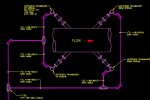NotreDave
Member
- Location
- Geismar, Louisiana
All,
I need some help please. I am sort of lost. I am running a coax cable (see attached) in a 3/4" conduit. It will fit in the conduit with no problem at all, my question is looking at the minimum bending radius of the cable, which is 2.5 inches, I don't think a regular crouse-hinds 3/4" LB27 will work due to the max. bend radius of that fitting. I will use a 1" crouse hinds BUB3 for the 90 degree bends. I have a problem and need guidance when specifying a "TEE", because "tee" fittings are required for this installation. According to the chart (link below), I would have to go to a 1-1/2", mark 9 T59. The plant (ExxonMobil) uses Form 7 fittings. I am so confused on this issue and would love someone to enlighten me on code or rule of thumb. The manufacturer told me I could wrap the coax around my finger, lol. i would love to hear what you all have to say about this! Are there other charts out there, excel spreadsheets, calculators, that could help me in the future? I thank you much in advance.
David
http://www.cooperindustries.com/con...trial-fittings-bend-radius-cubic-capacity.pdf
I need some help please. I am sort of lost. I am running a coax cable (see attached) in a 3/4" conduit. It will fit in the conduit with no problem at all, my question is looking at the minimum bending radius of the cable, which is 2.5 inches, I don't think a regular crouse-hinds 3/4" LB27 will work due to the max. bend radius of that fitting. I will use a 1" crouse hinds BUB3 for the 90 degree bends. I have a problem and need guidance when specifying a "TEE", because "tee" fittings are required for this installation. According to the chart (link below), I would have to go to a 1-1/2", mark 9 T59. The plant (ExxonMobil) uses Form 7 fittings. I am so confused on this issue and would love someone to enlighten me on code or rule of thumb. The manufacturer told me I could wrap the coax around my finger, lol. i would love to hear what you all have to say about this! Are there other charts out there, excel spreadsheets, calculators, that could help me in the future? I thank you much in advance.
David
http://www.cooperindustries.com/con...trial-fittings-bend-radius-cubic-capacity.pdf


